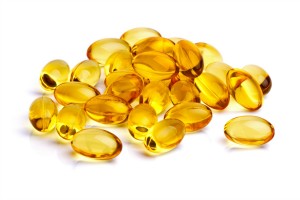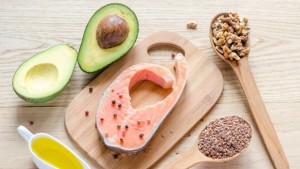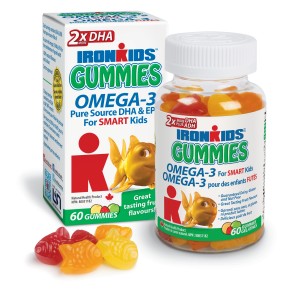 Science and research have long praised the benefits of omega-3 fatty acids. Fatty acids are vital to our brain’s function and structure, and the most important of the fatty acids is omega-3. Two of the most talked about omega-3s is DHA (docosahexaenoic acid) and EPA (eicosapentaenoic acid) as both have crucial roles with regards to the brain. DHA plays a vital role in the development of the brain, and EPA is crucial for brain function. A study found that children with ADHD tend to have lower concentrations of DHA and EPA which in turn, affects the brain’s development and functioning – possibly resulting in more ADHD symptoms. Recent studies suggest that intake of DHA and EPA certain consumption levels may yield benefits for children with ADHD or ADHD-type symptoms.
Science and research have long praised the benefits of omega-3 fatty acids. Fatty acids are vital to our brain’s function and structure, and the most important of the fatty acids is omega-3. Two of the most talked about omega-3s is DHA (docosahexaenoic acid) and EPA (eicosapentaenoic acid) as both have crucial roles with regards to the brain. DHA plays a vital role in the development of the brain, and EPA is crucial for brain function. A study found that children with ADHD tend to have lower concentrations of DHA and EPA which in turn, affects the brain’s development and functioning – possibly resulting in more ADHD symptoms. Recent studies suggest that intake of DHA and EPA certain consumption levels may yield benefits for children with ADHD or ADHD-type symptoms.
 A UK study found that children with ADHD and children with related behaviour and learning difficulties (such as dyspraxia and dyslexia) have lower amounts of DHA in their blood. Lower levels of DHA were associated with poorer reading ability and working memory performance. In this study, they showed that these children benefited from dietary DHA supplements; where behaviour problems, working memory and reading improved as the amount of DHA present in their blood increased. However, some researchers from an Oxford study did specify that though DHA supplementation may reduce ADHD-type behaviours for almost all children, DHA supplementation as an intervention for reading difficulties is best targeted at children whose reading is ‘poorest’ – poorest was qualified as being 2 years behind in reading level, in this Oxford study.
A UK study found that children with ADHD and children with related behaviour and learning difficulties (such as dyspraxia and dyslexia) have lower amounts of DHA in their blood. Lower levels of DHA were associated with poorer reading ability and working memory performance. In this study, they showed that these children benefited from dietary DHA supplements; where behaviour problems, working memory and reading improved as the amount of DHA present in their blood increased. However, some researchers from an Oxford study did specify that though DHA supplementation may reduce ADHD-type behaviours for almost all children, DHA supplementation as an intervention for reading difficulties is best targeted at children whose reading is ‘poorest’ – poorest was qualified as being 2 years behind in reading level, in this Oxford study.
A Swedish study showed that 25% of children taking daily doses of omega-3 supplements experienced a significant decrease in ADHD symptoms after 3 months. After 6 months, about 50% showed better management of their ADHD symptoms.
You may be wondering, how much should the intake of omega-3 be for my child to see any benefits?
Our daily intake of omega-3s usually comes from food such as fish, flaxseed, canola oil and some dairy products like yogurt. However, according to a US study, only a small amount DHA and EPA is contributed to our daily omega-3 intake from food (around 40mg for a child based US statistics). Taking omega-3 supplements can thus increase the daily intake to the amount required to yield benefits. Some doctors recommend about 700-1000mg of omega-3s (containing essential fatty acids EPA and DHA at a 2:1 ratio) for children between the ages of 4 and 8, and 2000-2500mg for older children to see reductions in hyperactivity and impulsivity, and improvement in concentration.
 Omega-3 supplements may come in liquid form (e.g. cod liver oil), capsules or chewable gummies. Be sure to check how much omega-3 fatty acids are present in the various forms as the amount tends to vary. For example, chewable gummies tend to have a lot less omega-3s than capsules or liquid form. If your child dislikes liquid omega-3 supplements, you could try mixing it in with their favourite drinks such as juice or smoothies.
Omega-3 supplements may come in liquid form (e.g. cod liver oil), capsules or chewable gummies. Be sure to check how much omega-3 fatty acids are present in the various forms as the amount tends to vary. For example, chewable gummies tend to have a lot less omega-3s than capsules or liquid form. If your child dislikes liquid omega-3 supplements, you could try mixing it in with their favourite drinks such as juice or smoothies.
According to some doctors, improvement in some children with ADHD can be seen in just a few days, whereas some may only show improvement a few weeks or months down the road. So if you do decide to give your child omega-3 supplements, don’t feel discouraged or give up too soon, remain patient and optimistic and perhaps you might see the benefits!